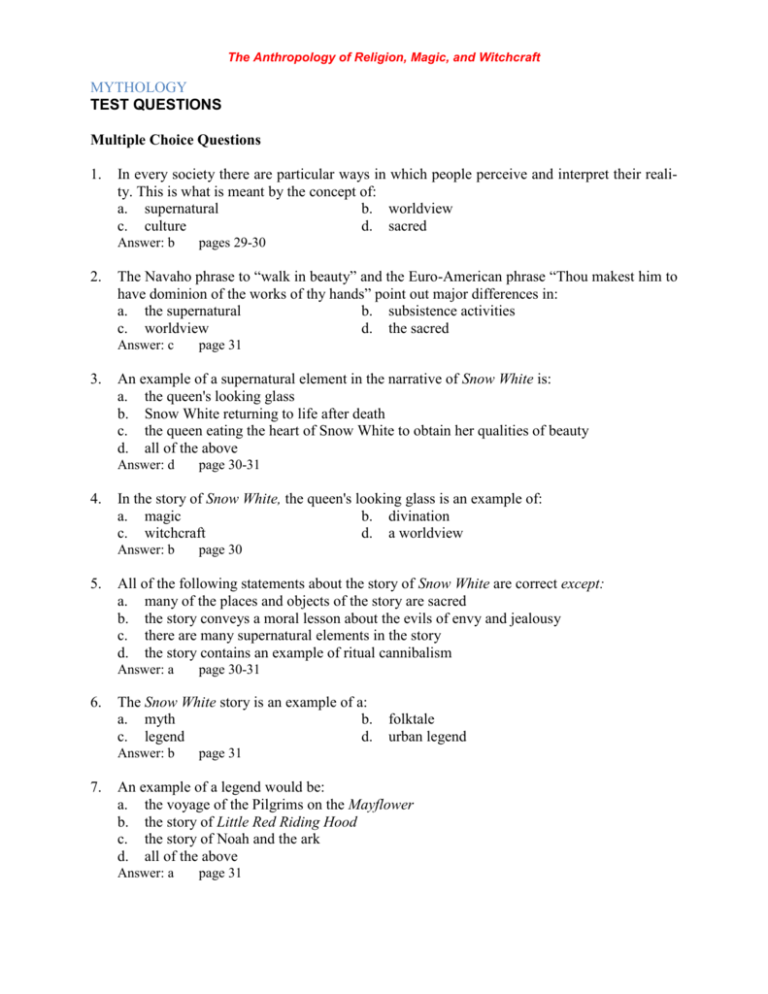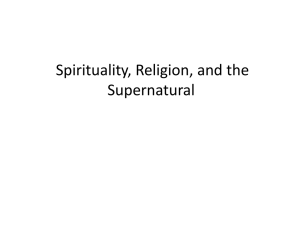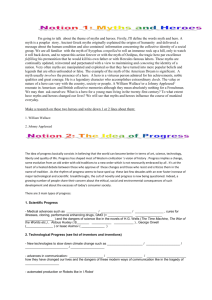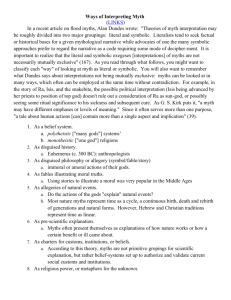The Anthropology of Religion, Magic, and Witchcraft MYTHOLOGY
advertisement

The Anthropology of Religion, Magic, and Witchcraft MYTHOLOGY TEST QUESTIONS Multiple Choice Questions 1. In every society there are particular ways in which people perceive and interpret their reality. This is what is meant by the concept of: a. supernatural b. worldview c. culture d. sacred Answer: b 2. The Navaho phrase to “walk in beauty” and the Euro-American phrase “Thou makest him to have dominion of the works of thy hands” point out major differences in: a. the supernatural b. subsistence activities c. worldview d. the sacred Answer: c 3. page 30-31 The Snow White story is an example of a: a. myth b. c. legend d. Answer: b 7. page 30 All of the following statements about the story of Snow White are correct except: a. many of the places and objects of the story are sacred b. the story conveys a moral lesson about the evils of envy and jealousy c. there are many supernatural elements in the story d. the story contains an example of ritual cannibalism Answer: a 6. page 30-31 In the story of Snow White, the queen's looking glass is an example of: a. magic b. divination c. witchcraft d. a worldview Answer: b 5. page 31 An example of a supernatural element in the narrative of Snow White is: a. the queen's looking glass b. Snow White returning to life after death c. the queen eating the heart of Snow White to obtain her qualities of beauty d. all of the above Answer: d 4. pages 29-30 folktale urban legend page 31 An example of a legend would be: a. the voyage of the Pilgrims on the Mayflower b. the story of Little Red Riding Hood c. the story of Noah and the ark d. all of the above Answer: a page 31 8. The story of crocodiles living in the sewers of New York City is an example of a: a. historical fact b. urban legend c. myth d. folktale Answer: b 9. page 31 Ritual texts: a. are social charters that sets forth the organization of human relationships b. explain the origins of humans and the world c. often contain multiple versions of the same story d. all of the above Answer: d pages 31, 37 10. Myths: a. are regarded as fact by those who accept this on faith b. include a great many sacred, supernatural elements c. take place in the past d. all of the above Answer: d page 31 11. Myths differ from folktales in that: a. myths are recounted in ritual and folktales are not b. myths reflect the worldview and folktales do not c. myths with the supernatural and folktales do not d. all of the above Answer: a pages 31-32 12. Which of the following is correct about oral texts? a. The recitation of oral texts is often a performance. b. The story may change with each telling. c. Different versions of the same story may exist in different places. d. all of the above Answer: d page 32-33 13. Which of the following is true about the myth of Genesis? a. there are two separate versions of creation told b. the stories reflect a patriarchal worldview c. the text acts as a social charter d. all of the above Answer: d page 36 14. The evolutionary school in the nineteenth century associated myths with: a. the “primitive period” b. the transition to modern times c. full modernity d. the future Answer: a page 39 15. Franz Boas and Bronislaw Malinowski are representative of proponents of the: a. structural analysis of myth b. psychological analysis of myth c. functional analysis of myth Answer: c d. evolutionary analysis of myth pages 40 16. The analysis of myth in terms of binary opposites is an example of: a. functional analysis b. structural analysis c. psychoanalytic analysis d. evolutionary analysis Answer: b pages 40-41 17. Freud described myths as: a. neuroses c. psychoanalysis Answer: b b. d. shared dreams psychological conflict page 41 18. A proposed relationship between early childhood experiences and adult projection systems like myths is characteristic of which analytic approach? a. functional analysis b. structural analysis c. psychoanalytic analysis d. evolutionary analysis Answer: c page 42 19. Jung believed that humans share inborn elements of the unconscious that are manifested in myths. He called this the: a. collective unconscious b. innate symbolism c. unconscious unified d. symbolic ancestry Answer: a page 42 20. Archetypes are: a. myths about the end of the world b. myths about a journey to the underworld c. a main character of the collective unconscious d. a main character in a hero story Answer: c page 42 21. The Navaho story Diné Bahanè is an example of a(n): a. origin story b. apocalyptic story c. trickster myth d. hero myth Answer: a page 44 22. The Navaho Creation Story takes place: a. in a special garden similar to the Judeo-Christian Garden of Eden b. in the realm of the gods in the sky c. in a series of layers that exist underneath the present world d. in another reality Answer: c pages 45-46 23. In the Navaho Creation Story, the Holy People appeared and explained that they wanted to create people: a. with the power of insects b. with supernatural powers c. who were giants d. with hands and feet like the Holy People Answer: d pages 45-46 24. In the Navaho Creation Story, First Man and First Woman were created from: a. dust b. ears of corn c. insects d. nothingness Answer: b pages 45-46 25. In the Navaho Creation Story, First Man and First Woman were created by the: a. Holy People b. Air-Spirit People c. People Who Live in Upright Houses d. sacred twins Answer: a pages 45-46 26. In the Navaho Creation Story, life was given to the first humans by the: a. Wind b. Sun c. Mountains d. Animal People Answer: a pages 45-46 27. An apocalypse is: a. the catastrophic destruction of the world b. the origin of the world through birth c. a god who gave is known for trickery and deceit d. a type of hero myth Answer: a page 46 28. The Book of Revelations in the New Testament is an example of a(n): a. trickster story b. hero myth c. apocalyptic myth d. origin story Answer: c page 47 29. A god who gave humans important things by accident or through deception is known as a(n): a. trickster b. hero c. deceit god d. creator god Answer: a page 48 30. The story “Raven Steals the Light” is an example of a: a. flood story b. hero story c. trickster story d. war story Answer: c pages 49-51 31. The story “Raven Steals the Light” tells us about the origin of the: a. earth b. sun and moon c. people d. salmon Answer: b pages 49-51 32. The monomyth is a narrative involving: a. b. c. d. the creation an explanation of illness and death a culture hero none of the above Answer: c page 51 33. The stories of Star Wars and Harry Potter most closely resemble: a. monomyths b. creation stories c. trickster stories d. apocalyptic stories Answer: a pages 52-53 True/False Questions 34. The Navaho worldview suggests an exploitation of natural resources by human society. Answer: F page 29-30 35. The Navaho phrase “to walk in beauty” refers to the accumulation of material goods. Answer: F page 30 36. The story of Snow White is not a religious story because it does not involve the sacred supernatural and is not the basis of ritual. Answer: T pages 30-31 37. The story of crocodiles living in the sewers of New York is an example of a myth. Answer: F page 31 38. To say that something is a myth means that it is not true. Answer: F page 31 39. Religious texts often change through time because they are often transmitted orally or subject to new translations. Answer: T page 32-33 40. In Islam, God spoke to Mohammad in Arabic, and Arabic is used in ritual today. Answer: T page 33 41. There are two creation stories in Genesis. In one man and woman are created together; in the other man was created first and woman was created later out of man’s rib. Answer: T pages 34-36 42. The Golden Bough is an example of an origin story. Answer: F page 39 43. Claude Levi-Strauss analyzed the structure of myths and pointed out tat humans tend to categorize the world in terms of binary opposites. Answer: T page 40 44. Émile Durkheim used a psychoanalytic approach to the analysis of myth and focused on the impact of myth on social structure. Answer: F pages 41-42 45. Proponents of the psychoanalytic approach to the analysis of myth see such stories as the Oedipus story as manifestations of the collective unconscious. Answer: T pages 42-43 46. An example of an archetype is the hero. Answer: T pages 42-43 47. In the Bunhongo Creation Story, Bumba vomits up the world. This is an example of the emergence myth. Answer: F page 43 49. In the Navaho Creation Story, the first humans were created by the two Holy People. Answer: F pages 44-47 48. The Christian New Testament contains an apocalyptic myth. Answer: T page 47 50. In the Haida story “The Raven Steals the Light,” the Raven is an example of a trickster. Answer: T pages 48-51 Essay Questions 51. What are the implications of the Navaho and the Euro-American worldviews with response to conservation? (pages 29-30) 52. Although the story of Snow White contains many supernatural elements and contains a moral lesson, it is not considered to be a religious story. Why? (pages 30-31) 53. What are the essential differences between Genesis and the Navaho Creation Story? (pages 33-36, 44-46) 54. What are some of the consequences of the oral transmission of myth compared with the written transmission of myth? (pages 32-33) 55. Discuss the Gururumba Creation Story from a structuralist point of view. (pages 40-42) 56. What was Sigmund Freud’s approach to the study of myth? (pages 41-42) 57. In what ways are trickster deities also creator deities? (page 47) 58. Give several examples of the monomyth seen in contemporary motion pictures. (pages 4748) SUMMARY The ways a society perceives and interprets its reality is known as its worldview. The worldview provides an understanding of how the world works; it forms the template for thought and behavior; and it provides a basic understanding of the origin and nature of humankind and its relationship to the world. People express their worldview in stories. Myths are sacred stories that tell of the origin of the world and humankind, the existence and activities of gods and spirits, the origin of human traditions, and the nature of illness and death. They tell how to behave and how to distinguish good from evil. Myths are thought to recount real, historical events that took place in the remote past. They provide the basis for religious beliefs and practices. Myths can be both written and oral. Written forms tend to be very stable through time, and changes that do occur are usually deliberate changes that are the consequences of translation or scholarly discourse about the meaning of particular words and passages. Oral texts are recited, and this recitation often has the characteristics of performance. One of the consequences of the oral transmission of stories is that they are frequently unconsciously altered with each generation, which explains the existence of different versions of the same myth within a society. There are many ways of interpreting myths. Functional analysis sees myths as forces that help to maintain the society. Structural analysis focuses on the underlying structure of myths. The psychoanalytic approach sees myths as symbolically expressing unconscious wishes. Certain basic themes are common through the world. Origin myths provide answers to the questions: Who are we? Why are we here? What is our relationship to the world? These stories play an important role in laying out the culture’s worldview. One common element is the birth metaphor, in which the world is born from a god or goddess or by creation out of chaos, darkness, or the void. Tricksters are part human, part animal. They are adventurers, seekers of sexual pleasures, lazy, dishonest, and impulsive. Yet tricksters are responsible for creating or bringing into the world many elements, often as a by-product of some other activity. Hero myths are stories about culture heroes who, through knowledge and mastery of certain skills, are able to bring about marvelous results. GLOSSARY Apocalypse: Ultimate devastation or the end of the world. (p. 46) Archetype: A main character of the collective unconscious. (p. 42) Collective unconscious: Inborn elements of the unconscious that are manifested in dreams and myths. (p. 42) Folktale: A traditional story that is a part of the tradition of a society; not considered to be true. (p. 31) Legend: A traditional story about past events that is considered to be true; usually contains an element of reality—a known character, event, or place. (p. 31) Monomyth: A theme common to many myths that tells of the adventures of a culture hero. (p. 51) Myth: A sacred story that provides the basis for religious beliefs and practices. (p. 31) Social charter: A story that establishes the proper organization and rules of behavior of a society. (p. 36) Trickster god: A god who gave humans important things or skills, often by accident or through trickery. (p. 48) Trickster story: A story involving a trickster deity. (p. 48) Urban legend: Contemporary story about people and events that never occurred, but are presented as real. (p. 31) Worldview: The way in which a society perceives and interprets its reality. (p. 29) DISCUSSION TOPICS How would you describe the worldview of your own culture? Although the United States is made up of a diverse population, can we say that there is a shared American worldview? If so, what characterizes this worldview? How is this worldview reflected in American culture? How do American media (including television and films) reflect the American worldview? In what ways are important American civil documents, such as the Declaration of Independence, like myths? In what ways are they different? Stories about supernatural topics (e.g., ghosts, angels, prophesies) can be found in informal venues such as the tabloids. Would you consider these to be religious stories or myths? Why or why not? Humans have been called “storytelling animals”. What is the importance of storytelling both for individuals and societies? Why do you think common themes are found in myths in different cultures? How does human psychology affect the nature of myths and the way we tell and perceive them? What recent movies have you seen that are based on the hero’s journey? Can you identify the stages? STUDENT PROJECTS While in many societies stories are told through story tellers, stories in American society are frequently told through movies and television. Pick a movie or television and show and explain how the show reflects the American worldview. Select a foreign film. What cultural differences can be seen between your own culture and the culture portrayed in the film? Pick a movie that tells the story of the monomyth. Describe how it fits the monomyth structure. Locate myths from two or more different cultures. Analyze each myth and show how they are similar to or differ from one another.







